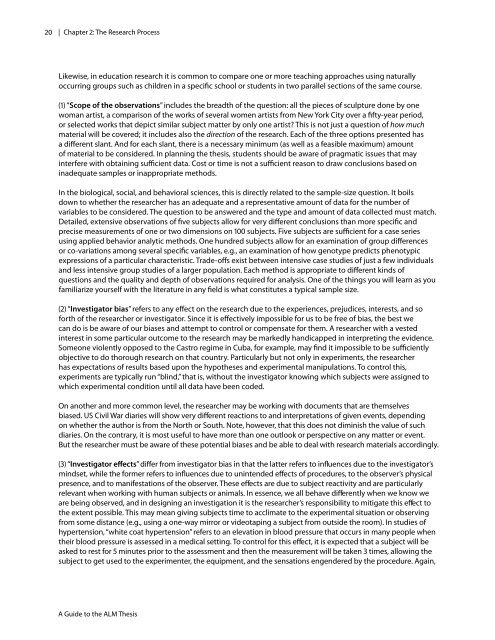A Guide to the ALM Thesis - iSites - Harvard University
A Guide to the ALM Thesis - iSites - Harvard University
A Guide to the ALM Thesis - iSites - Harvard University
You also want an ePaper? Increase the reach of your titles
YUMPU automatically turns print PDFs into web optimized ePapers that Google loves.
20<br />
| Chapter 2: The Research Process<br />
Likewise, in education research it is common <strong>to</strong> compare one or more teaching approaches using naturally<br />
occurring groups such as children in a specific school or students in two parallel sections of <strong>the</strong> same course.<br />
(1) “ Scope of <strong>the</strong> observations” includes <strong>the</strong> breadth of <strong>the</strong> question: all <strong>the</strong> pieces of sculpture done by one<br />
woman artist, a comparison of <strong>the</strong> works of several women artists from New York City over a fifty-year period,<br />
or selected works that depict similar subject matter by only one artist? This is not just a question of how much<br />
material will be covered; it includes also <strong>the</strong> direction of <strong>the</strong> research. Each of <strong>the</strong> three options presented has<br />
a different slant. And for each slant, <strong>the</strong>re is a necessary minimum (as well as a feasible maximum) amount<br />
of material <strong>to</strong> be considered. In planning <strong>the</strong> <strong>the</strong>sis, students should be aware of pragmatic issues that may<br />
interfere with obtaining sufficient data. Cost or time is not a sufficient reason <strong>to</strong> draw conclusions based on<br />
inadequate samples or inappropriate methods.<br />
In <strong>the</strong> biological, social, and behavioral sciences, this is directly related <strong>to</strong> <strong>the</strong> sample-size question. It boils<br />
down <strong>to</strong> whe<strong>the</strong>r <strong>the</strong> researcher has an adequate and a representative amount of data for <strong>the</strong> number of<br />
variables <strong>to</strong> be considered. The question <strong>to</strong> be answered and <strong>the</strong> type and amount of data collected must match.<br />
Detailed, extensive observations of five subjects allow for very different conclusions than more specific and<br />
precise measurements of one or two dimensions on 100 subjects. Five subjects are sufficient for a case series<br />
using applied behavior analytic methods. One hundred subjects allow for an examination of group differences<br />
or co-variations among several specific variables, e.g., an examination of how genotype predicts phenotypic<br />
expressions of a particular characteristic. Trade-offs exist between intensive case studies of just a few individuals<br />
and less intensive group studies of a larger population. Each method is appropriate <strong>to</strong> different kinds of<br />
questions and <strong>the</strong> quality and depth of observations required for analysis. One of <strong>the</strong> things you will learn as you<br />
familiarize yourself with <strong>the</strong> literature in any field is what constitutes a typical sample size.<br />
(2) “ Investiga<strong>to</strong>r bias” refers <strong>to</strong> any effect on <strong>the</strong> research due <strong>to</strong> <strong>the</strong> experiences, prejudices, interests, and so<br />
forth of <strong>the</strong> researcher or investiga<strong>to</strong>r. Since it is effectively impossible for us <strong>to</strong> be free of bias, <strong>the</strong> best we<br />
can do is be aware of our biases and attempt <strong>to</strong> control or compensate for <strong>the</strong>m. A researcher with a vested<br />
interest in some particular outcome <strong>to</strong> <strong>the</strong> research may be markedly handicapped in interpreting <strong>the</strong> evidence.<br />
Someone violently opposed <strong>to</strong> <strong>the</strong> Castro regime in Cuba, for example, may find it impossible <strong>to</strong> be sufficiently<br />
objective <strong>to</strong> do thorough research on that country. Particularly but not only in experiments, <strong>the</strong> researcher<br />
has expectations of results based upon <strong>the</strong> hypo<strong>the</strong>ses and experimental manipulations. To control this,<br />
experiments are typically run “blind,” that is, without <strong>the</strong> investiga<strong>to</strong>r knowing which subjects were assigned <strong>to</strong><br />
which experimental condition until all data have been coded.<br />
On ano<strong>the</strong>r and more common level, <strong>the</strong> researcher may be working with documents that are <strong>the</strong>mselves<br />
biased. US Civil War diaries will show very different reactions <strong>to</strong> and interpretations of given events, depending<br />
on whe<strong>the</strong>r <strong>the</strong> author is from <strong>the</strong> North or South. Note, however, that this does not diminish <strong>the</strong> value of such<br />
diaries. On <strong>the</strong> contrary, it is most useful <strong>to</strong> have more than one outlook or perspective on any matter or event.<br />
But <strong>the</strong> researcher must be aware of <strong>the</strong>se potential biases and be able <strong>to</strong> deal with research materials accordingly.<br />
(3) “ Investiga<strong>to</strong>r effects” differ from investiga<strong>to</strong>r bias in that <strong>the</strong> latter refers <strong>to</strong> influences due <strong>to</strong> <strong>the</strong> investiga<strong>to</strong>r’s<br />
mindset, while <strong>the</strong> former refers <strong>to</strong> influences due <strong>to</strong> unintended effects of procedures, <strong>to</strong> <strong>the</strong> observer’s physical<br />
presence, and <strong>to</strong> manifestations of <strong>the</strong> observer. These effects are due <strong>to</strong> subject reactivity and are particularly<br />
relevant when working with human subjects or animals. In essence, we all behave differently when we know we<br />
are being observed, and in designing an investigation it is <strong>the</strong> researcher’s responsibility <strong>to</strong> mitigate this effect <strong>to</strong><br />
<strong>the</strong> extent possible. This may mean giving subjects time <strong>to</strong> acclimate <strong>to</strong> <strong>the</strong> experimental situation or observing<br />
from some distance (e.g., using a one-way mirror or videotaping a subject from outside <strong>the</strong> room). In studies of<br />
hypertension, “white coat hypertension” refers <strong>to</strong> an elevation in blood pressure that occurs in many people when<br />
<strong>the</strong>ir blood pressure is assessed in a medical setting. To control for this effect, it is expected that a subject will be<br />
asked <strong>to</strong> rest for 5 minutes prior <strong>to</strong> <strong>the</strong> assessment and <strong>the</strong>n <strong>the</strong> measurement will be taken 3 times, allowing <strong>the</strong><br />
subject <strong>to</strong> get used <strong>to</strong> <strong>the</strong> experimenter, <strong>the</strong> equipment, and <strong>the</strong> sensations engendered by <strong>the</strong> procedure. Again,<br />
A <strong>Guide</strong> <strong>to</strong> <strong>the</strong> <strong>ALM</strong> <strong>Thesis</strong>

















